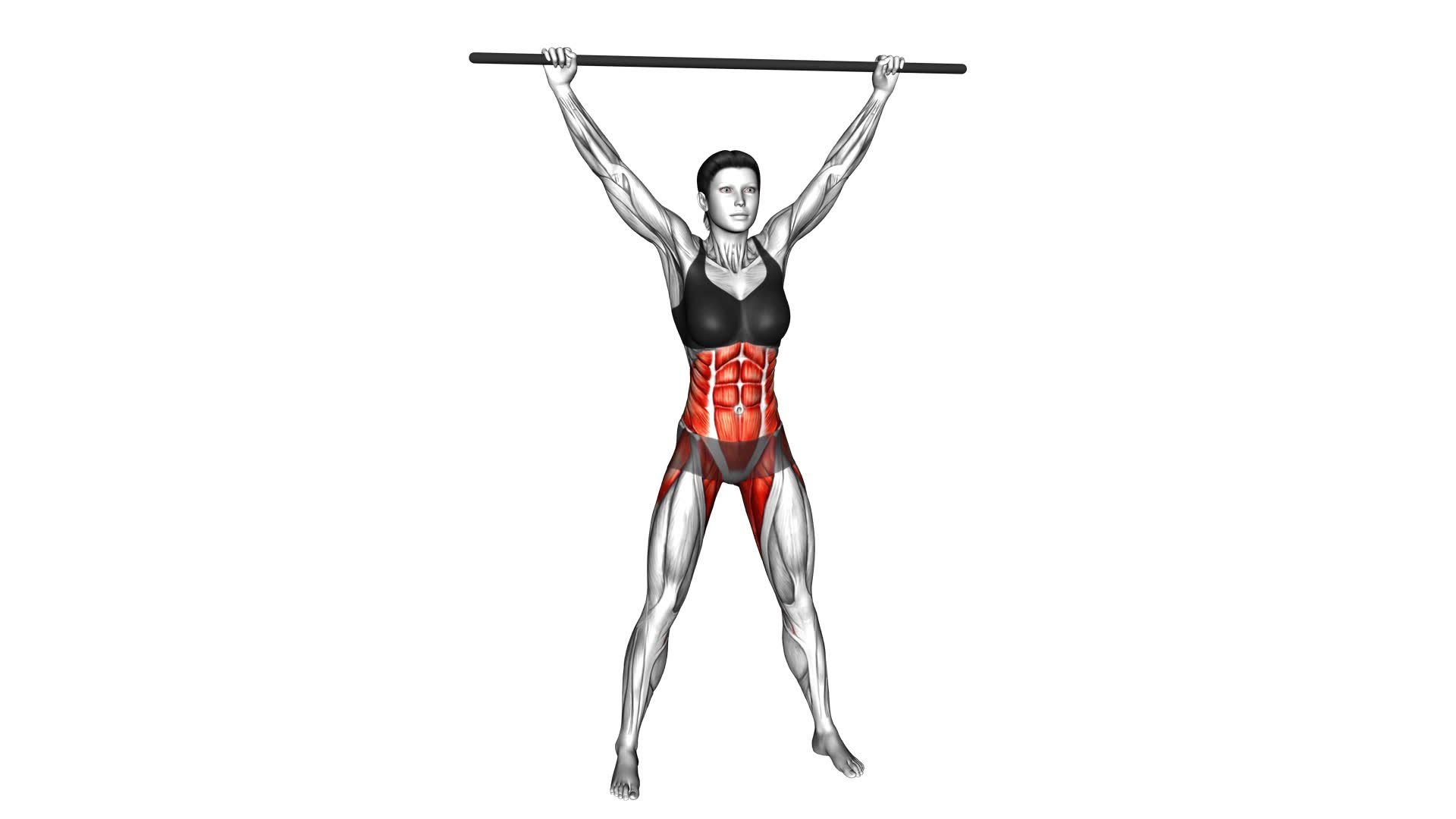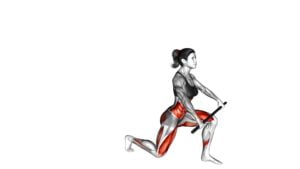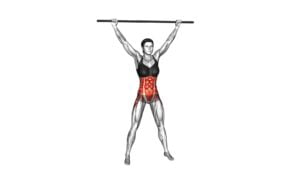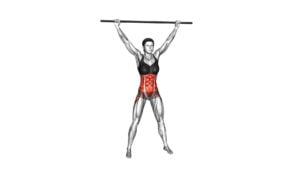Stick Standing Twist Stretch (female) – Video Exercise Guide & Tips

Looking to improve your flexibility and core strength?
Watch This Exercise Video
Check out the Stick Standing Twist Stretch!
This exercise guide and video provides step-by-step instructions and helpful tips for performing the stretch correctly.
Whether you're a beginner or more advanced in your fitness journey, there are modifications and progressions to suit your needs.
Get ready to maximize your stretch and avoid common mistakes with this informative and concise guide.
Let's get twisting and stretching!
Key Takeaways
- The Stick Standing Twist Stretch is beneficial for improving flexibility, preventing injuries, increasing range of motion, and enhancing overall flexibility.
- Proper form and technique include standing with feet shoulder-width apart, holding a stick or broomstick behind the neck, keeping elbows pointing forward and chest lifted, engaging the core, and slowly rotating the upper body.
- Common mistakes to avoid include improper body alignment, lack of proper breathing, overexertion and strain, hunching shoulders or rounding back, and holding breath or breathing irregularly.
- Modifications and progressions for all fitness levels include reducing range of motion for beginners, using a shorter stick or broomstick, decreasing the number of repetitions, taking breaks as needed, and incorporating dynamic movements and resistance for advanced practitioners.
Benefits of the Stick Standing Twist Stretch
To maximize the effectiveness of your stick standing twist stretch, it's important to understand the numerous benefits that this exercise offers. The stick standing twist stretch is highly effective in improving flexibility and preventing injuries. By incorporating this stretch into your routine, you can significantly increase your range of motion and enhance your overall flexibility. This is particularly beneficial for athletes and individuals involved in activities that require agility and quick movements.
Improved flexibility is essential for preventing injuries. When your muscles are more flexible, they're better able to withstand stress and strain during physical activity. This can help reduce the risk of muscle strains, tears, and other injuries. Additionally, the stick standing twist stretch helps to increase blood flow to your muscles, promoting better circulation and aiding in injury prevention.
Incorporating the stick standing twist stretch into your routine can help you achieve improved flexibility and reduce the risk of injuries. By properly stretching and warming up your muscles, you prepare your body for physical activity and ensure that you're performing at your best.
In the following section, we'll discuss the proper form and technique for this exercise, so you can reap all of its benefits safely and effectively.
Proper Form and Technique for the Exercise
To perform the stick standing twist stretch with proper form and technique, follow these steps.
- Start by standing with your feet shoulder-width apart and hold a stick or broomstick horizontally behind your neck, resting it on your shoulders.
- Keep your elbows pointing forward and your chest lifted throughout the exercise.
- To begin the twist, engage your core and slowly rotate your upper body to the right, allowing your hips and lower body to follow.
- Be sure to maintain proper alignment by keeping your head aligned with your spine and your gaze forward.
- As you twist, exhale and feel the stretch in your torso and oblique muscles.
- Hold the twist for a few seconds, then slowly return to the starting position.
- Repeat the twist to the left side, again focusing on maintaining good alignment and feeling the stretch in your muscles.
- Perform 8-10 repetitions on each side, gradually increasing the range of motion as your flexibility improves.
Remember, proper technique and body alignment are crucial for maximizing the effectiveness of the stick standing twist stretch.
Pay attention to your form and listen to your body, avoiding any excessive twisting or strain.
As always, consult with a fitness professional before attempting any new exercise, especially if you have any pre-existing injuries or conditions.
Common Mistakes to Avoid
To perform the Stick Standing Twist Stretch correctly and effectively, it's important to avoid common mistakes that can hinder your progress.
First, make sure to maintain proper body alignment throughout the exercise, keeping your spine straight and shoulders relaxed.
Additionally, focus on breathing deeply and exhaling fully to enhance the stretch and prevent tension build-up.
Finally, be mindful of not overexerting yourself or straining your muscles, as this can lead to injury.
Improper Body Alignment
Avoid common mistakes in your body alignment while performing the Stick Standing Twist Stretch (female) exercise. Proper body alignment is crucial for injury prevention and developing body awareness.
When performing this exercise, ensure that your feet are hip-width apart and your knees are slightly bent. Keep your spine straight, shoulders relaxed, and chest lifted. Avoid hunching your shoulders or rounding your back, as this can lead to strain and potential injury. Engage your core muscles to maintain stability and support your spine.
As you twist, focus on rotating from your torso rather than just your arms. Maintain a balanced and controlled movement throughout the exercise.
Lack of Proper Breathing
Breathe properly to avoid making common mistakes during the Stick Standing Twist Stretch (female) exercise. Proper breathing is essential for maximizing the benefits of deep breathing and improving your overall performance. Here are some techniques for improving your breathing during the exercise:
- Diaphragmatic breathing: Focus on breathing deeply into your diaphragm, allowing your belly to expand as you inhale and contract as you exhale.
- Slow and controlled breaths: Take slow, deep breaths to ensure a steady flow of oxygen to your muscles.
- Exhale on the twist: Coordinate your exhale with the twisting movement, helping to engage your core and increase flexibility.
- Avoid breath-holding: Remember to breathe continuously throughout the exercise, avoiding the tendency to hold your breath.
Overexertion and Strain
To prevent overexertion and strain, it's important for you to maintain proper form and listen to your body's signals during the Stick Standing Twist Stretch (female) exercise.
Overexertion injuries can occur when you push yourself too hard and exceed your body's limits. It's crucial to avoid this by staying within a comfortable range of motion and not forcing any movements.
Additionally, be mindful of any pain or discomfort during the exercise, as this could be a sign of strain. If you experience any pain, stop immediately and consult a healthcare professional.
By practicing proper form and listening to your body, you can prevent strains and injuries.
Now, let's move on to discussing modifications and progressions for all fitness levels.
Modifications and Progressions for All Fitness Levels
Now let's talk about modifications and progressions that can be made to the Stick Standing Twist Stretch to accommodate individuals of all fitness levels.
Whether you're a beginner looking for adaptations or an advanced practitioner seeking more challenges, there are options available to suit your needs.
These modifications and progressions will help you customize the exercise to your current fitness level and continue to challenge yourself as you progress.
Adaptations for Beginners
Your fitness level can be easily modified and progressed with adaptations for beginners. Here are some modifications and progressions that you can implement to tailor the Stick Standing Twist Stretch to your fitness level:
- Reduce the range of motion: If you find it challenging to twist your upper body, start with smaller movements and gradually increase the range of motion as you build strength and flexibility.
- Use a shorter stick: If the stick you're using feels too long or heavy, try using a shorter stick or even a broomstick to make the exercise more manageable for beginners.
- Decrease the number of repetitions: If you're struggling to complete the recommended number of repetitions, start with fewer reps and gradually increase them over time.
- Take breaks as needed: Listen to your body and take breaks whenever necessary. It's important to pace yourself and not push too hard, especially when starting out.
Challenges for Advanced Practitioners
Increase the intensity of your Stick Standing Twist Stretch by incorporating dynamic movements and adding resistance.
For advanced practitioners, there are various modifications and progressions you can implement to challenge yourself further. To modify the exercise, you can increase the speed of your twists or use a weighted stick for added resistance. This will engage your core and upper body muscles more effectively.
Another advanced progression is to perform the twist stretch on an unstable surface, such as a balance board or stability ball, which will require more stability and balance.
These advanced modifications and progressions will help you take your Stick Standing Twist Stretch to the next level, improving your strength, flexibility, and overall fitness.
Now, let's move on to some tips for getting the most out of your stretch.
Tips for Getting the Most Out of Your Stretch
To maximize your stretch, focus on proper form and breathing techniques. Here are some tips to help you get the most out of your stretching routine:
- Warm up: Before starting your stretching exercises, it's important to warm up your muscles. This can be done through light cardio exercises like jogging or jumping jacks. Warming up increases blood flow and prepares your muscles for stretching.
- Gradual progression: Start with gentle stretches and gradually increase the intensity and duration over time. Pushing yourself too hard can lead to injury, so listen to your body and go at your own pace.
- Hold the stretch: When stretching, hold each position for 20-30 seconds. This allows your muscles to lengthen and promotes flexibility. Avoid bouncing or jerking movements, as they can strain your muscles.
- Breathe deeply: Focus on your breathing while stretching. Inhale deeply through your nose and exhale slowly through your mouth. Deep breathing helps relax your muscles and enhances the effectiveness of the stretch.
By following these tips, you can improve your flexibility and achieve maximum results from your stretching routine. Remember to always prioritize your safety and listen to your body's limits.
Happy stretching!
Safety Precautions and Considerations
To ensure a safe and effective stretching routine, it's important to take certain safety precautions and considerations. By following these guidelines, you can prevent injuries and maximize the benefits of your stretching exercises.
First and foremost, it's crucial to warm up your body before engaging in any stretching routine. This helps to increase blood flow to your muscles, making them more pliable and less prone to injury. Some effective warm-up exercises include jogging in place, jumping jacks, or even a brisk walk.
Additionally, it's essential to listen to your body and never push yourself beyond your limits. Stretching should never be painful. Instead, focus on a gentle and controlled stretch, gradually increasing the intensity over time. Remember to breathe deeply and relax into each stretch.
Furthermore, it's important to maintain proper form throughout your stretches. This means aligning your body correctly and avoiding any jerky or sudden movements. It's advisable to seek guidance from a qualified fitness professional to ensure you're performing the stretches correctly and safely.
Lastly, it's crucial to stretch both sides of your body equally. This helps to maintain balance and prevent muscle imbalances that can lead to injuries.
Frequently Asked Questions
How Long Should I Hold the Stick Standing Twist Stretch?
To get the most out of the stick standing twist stretch, it's important to know how long to hold it. The duration of this stretch can vary depending on your fitness level and flexibility. Generally, holding the stretch for around 20-30 seconds is a good starting point.
As you progress, you can gradually increase the holding time. This exercise helps improve flexibility, spinal mobility, and posture.
Can I Perform the Stick Standing Twist Stretch if I Have a Previous Injury or Condition?
Yes, you can perform the stick standing twist stretch even if you have a previous injury or condition.
However, it's important to consult with a healthcare professional or a qualified trainer before attempting this exercise. They can provide guidance tailored to your specific situation and help you modify the stretch if needed.
Keep in mind that if you have limited flexibility or a previous injury, you may need to take extra precautions and perform the stretch with caution.
Is It Necessary to Warm up Before Performing the Stick Standing Twist Stretch?
Before performing the stick standing twist stretch, it's necessary to warm up. Warming up helps prepare your muscles and joints for the exercise, reducing the risk of injury. It increases blood flow, flexibility, and range of motion.
The stick standing twist stretch has different variations, allowing you to target various muscle groups. It helps improve spinal mobility, core strength, and posture.
Remember to start with a warm-up routine to maximize the benefits of this stretch.
Can I Perform the Stick Standing Twist Stretch if I Have Limited Flexibility or Range of Motion?
If you have limited flexibility or range of motion, there are modifications you can make to perform the stick standing twist stretch.
By adjusting the distance between your hands on the stick and the intensity of the twist, you can tailor the exercise to your abilities.
The stick standing twist stretch is beneficial for improving flexibility and range of motion because it stretches the muscles in your upper body and spine.
It's important to listen to your body and not push yourself too far.
How Often Should I Incorporate the Stick Standing Twist Stretch Into My Workout Routine?
Incorporating the stick standing twist stretch into your workout routine can help with injury prevention and improving flexibility. It's suggested to perform this stretch 2-3 times a week, allowing for rest days in between.
However, it's important to listen to your body and not overdo it. If you have limited flexibility or range of motion, there are alternative stretches that can still provide similar benefits.
Consult with a fitness professional for personalized recommendations.
Conclusion
In conclusion, the stick standing twist stretch is a beneficial exercise for improving flexibility and mobility.
By following proper form and technique, avoiding common mistakes, and making modifications as needed, individuals of all fitness levels can benefit from this stretch.
Remember to prioritize safety and listen to your body's limitations.
Incorporate this stretch into your routine to maximize its effectiveness and enhance your overall fitness journey.

Author
Years ago, the spark of my life’s passion ignited in my mind the moment I stepped into the local gym for the first time. The inaugural bead of perspiration, the initial endeavor, the very first surge of endorphins, and a sense of pride that washed over me post-workout marked the beginning of my deep-seated interest in strength sports, fitness, and sports nutrition. This very curiosity blossomed rapidly into a profound fascination, propelling me to earn a Master’s degree in Physical Education from the Academy of Physical Education in Krakow, followed by a Sports Manager diploma from the Jagiellonian University. My journey of growth led me to gain more specialized qualifications, such as being a certified personal trainer with a focus on sports dietetics, a lifeguard, and an instructor for wellness and corrective gymnastics. Theoretical knowledge paired seamlessly with practical experience, reinforcing my belief that the transformation of individuals under my guidance was also a reflection of my personal growth. This belief holds true even today. Each day, I strive to push the boundaries and explore new realms. These realms gently elevate me to greater heights. The unique combination of passion for my field and the continuous quest for growth fuels my drive to break new ground.







